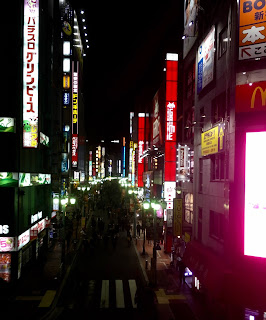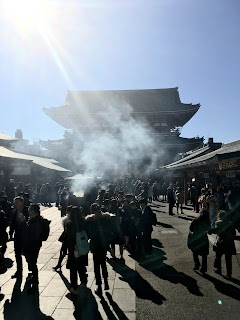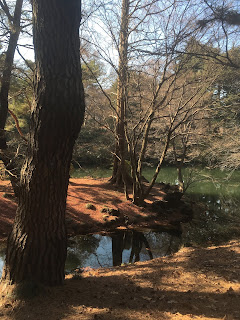 Japan in winter. This is a long anticipated trip, a rail tour starting in Tokyo and then south and east. The depth of winter seems like an odd time to choose, but the weather then is supposed to be cool, dry and often sunny. So it proved, with mostly clear blue skies throughout our first week – in fact, exceptionally good for the great amount of walking we hoped to do in the capital. First task after the train from Narita airport was to find our way out of the sprawling Tokyo station. I had done my homework though, and soon we were on the streets of Ginza, a hotel and business district just by the station. First impressions were of a prosperous working environment. Tall modern blocks shaded the narrow streets, lined with many small bars and restaurants. Our hotel was well located and the staff helpfully gave us a local map highlighting good local places to eat.
Japan in winter. This is a long anticipated trip, a rail tour starting in Tokyo and then south and east. The depth of winter seems like an odd time to choose, but the weather then is supposed to be cool, dry and often sunny. So it proved, with mostly clear blue skies throughout our first week – in fact, exceptionally good for the great amount of walking we hoped to do in the capital. First task after the train from Narita airport was to find our way out of the sprawling Tokyo station. I had done my homework though, and soon we were on the streets of Ginza, a hotel and business district just by the station. First impressions were of a prosperous working environment. Tall modern blocks shaded the narrow streets, lined with many small bars and restaurants. Our hotel was well located and the staff helpfully gave us a local map highlighting good local places to eat. We really did walk, encouraged by that brilliantly clear weather – 58km in our four days there – and walking is always the best way to get a feel for a city. And it's easy there. Good pavements, clear crossings (pedestrian lights strictly obeyed) and no mad cyclists, with clear maps and signs everywhere. The subway is also easy to navigate and we used this to go between districts. Signs in fact are almost the dominant feature of Tokyo. Every building seems to be covered in them, and at night they glow and trhob with life. This is perhaps the biggest surprise to me about Japan. In the west we regarded Japan as the source of good modernist taste: clean lines, minimalist, restrained design. And you can still find some of that, but for the most part the buildings are banal and plastered with ugly advertising. Hardly any old buildings survive (except the few set piece palaces and shrines), but that can largely be blamed on the war, earthquakes and fires.
We visited some of Tokyo's other well known centres (like London, it has developed from a series of separate villages and some of them retain their own character. Shibuya and Shinjuku are major hubs with vast crowds thronging the pavements at all hours. We saw the famous Shibuya crossing and the louche back lanes of Shinjuku's nightlife areas. Other highlights:
 Asakusa and the Senso-ji shrine. This is Tokyo's oldest and most revered temple. But little sign of reverence here. It is surrounded by curio shops and markets and thronged with giggling school parties, as well as family groups in traditional dress taking selfies. A spectator's dream: theatre of the street. There are lucky charm stalls and methods of establishing whether you are in for good or bad luck – and you can leave the bad luck behind (for a fee). The temple itself, its pagoda and entrance gate, are impressive, with vast paper lanterns and swirling clouds of incense, and a lot of enjoyment: a far cry from the dour restraint of other religions.
Asakusa and the Senso-ji shrine. This is Tokyo's oldest and most revered temple. But little sign of reverence here. It is surrounded by curio shops and markets and thronged with giggling school parties, as well as family groups in traditional dress taking selfies. A spectator's dream: theatre of the street. There are lucky charm stalls and methods of establishing whether you are in for good or bad luck – and you can leave the bad luck behind (for a fee). The temple itself, its pagoda and entrance gate, are impressive, with vast paper lanterns and swirling clouds of incense, and a lot of enjoyment: a far cry from the dour restraint of other religions. A very different experience, and spectacular building, is to be found at the Tsukiji Hongwanji temple in Ginza. Built of stone, in ancient Indian style, it is much more church-like and belongs to a Buddhist sect, Jodoshinshu, whose view of a redemptive Buddha seems to chime with Christian thought. Nearby is the sprawling fish market, which is gradually moving over into tourism but still retains a feeling of a living market, with every kind of seafood and little stalls and snack bars selling steaming skewers of fish or, of course, sushi and sashimi.
 The National Garden at Shinjuku, Tokyo's Kew, was originally a private garden of the Emperor and features tradiitonal Japanese style sections with tea houses and shady rest areas, as well as English and French landscapes and a big glasshouse with tropical displays. It has many beautiful prospects across water, and although largely muted winter sienna shades after a prologed dry spell, there were harbingers of spring with daffodils, camelias and even some early blossom. We also visited the Hama-Rikyu gardens, formerly the site of an Edo stronghold by the waterfront looking over (now largely reclaimed with massive tower blocks) Tokyo Bay*. Ueno's park was disappointing, poorly maintained and overbuilt with museums and a Starbuck's, though there is a good shrine.
The National Garden at Shinjuku, Tokyo's Kew, was originally a private garden of the Emperor and features tradiitonal Japanese style sections with tea houses and shady rest areas, as well as English and French landscapes and a big glasshouse with tropical displays. It has many beautiful prospects across water, and although largely muted winter sienna shades after a prologed dry spell, there were harbingers of spring with daffodils, camelias and even some early blossom. We also visited the Hama-Rikyu gardens, formerly the site of an Edo stronghold by the waterfront looking over (now largely reclaimed with massive tower blocks) Tokyo Bay*. Ueno's park was disappointing, poorly maintained and overbuilt with museums and a Starbuck's, though there is a good shrine. As a special treat we had dinner in a 10 seat, highly rated restaurant where we could watch the young chef prepare our 11 course tasting menu, Ian bravely sampling the many fish dishes, including potentially poisonous blowfish. The accompanying sake pairings to each course – a real education this – perhaps made it easier. Many restaurants and bars here are tiny, seating no more than about 10, who normally squeeze in to sit at the bar to drink and eat. Most specialise in one particular type of food or drink. The economics of this is mystifying. A far cry from London's stultifying takeover by bland chains.
*Footnote for birders: In Hama-Rikyu garden we found a gaggle of excited bird fanciers focusing their huge camouflaged cameras on a particular tree. There was what we later found out was a Blakiston's fish owl (Bubo blakistoni), of which only a few hundred pairs survive in Hokkaido, Japan's remote norhtern island. This is a type of eagle owl, and the largest owl in the world. It sat on a low branch over the ornamental pond, well stocked with carp too big even for its big talons, staring back at us, in a rather cross eyed fashion, and occasionally preening itself. What it was doing hundreds of miles south in a busy urban park in one of the world's busiest cities was anyone's guess.
*Footnote for birders: In Hama-Rikyu garden we found a gaggle of excited bird fanciers focusing their huge camouflaged cameras on a particular tree. There was what we later found out was a Blakiston's fish owl (Bubo blakistoni), of which only a few hundred pairs survive in Hokkaido, Japan's remote norhtern island. This is a type of eagle owl, and the largest owl in the world. It sat on a low branch over the ornamental pond, well stocked with carp too big even for its big talons, staring back at us, in a rather cross eyed fashion, and occasionally preening itself. What it was doing hundreds of miles south in a busy urban park in one of the world's busiest cities was anyone's guess.
